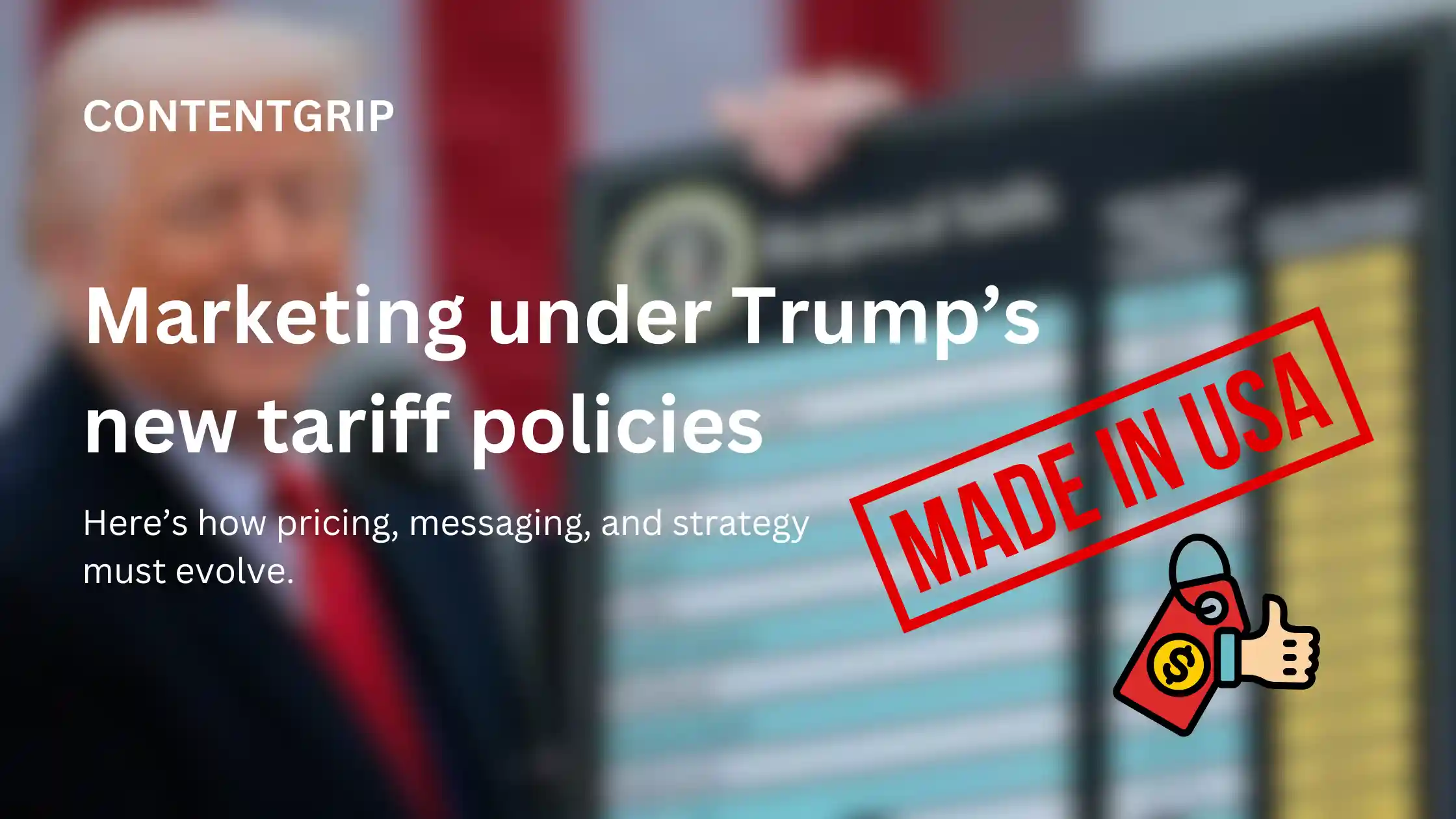Marketing under Trump’s new tariff policies
As the world reacts to sweeping U.S. import tariffs, smart brands are adjusting their campaigns, supply chains, and customer comms.

In April 2025, President Donald Trump triggered new trade tensions by imposing a blanket 10% tariff on all U.S. imports—hitting Vietnam, China, Taiwan, and the EU even harder. While the headlines focus on politics and recession risks, the real impact is already rippling through supply chains, pricing, and consumer sentiment.
For marketers, this isn't just background noise—it’s a direct hit to brand storytelling, pricing strategies, and cross-border campaigns.
This article breaks down what the recent tariff is all about, why marketers should care, and what steps they should take now.
Short on time?
Here is a table of content for quick access to what you need:
- What was the recent tariff imposed by Trump all about?
- Why should marketers care?
- What should marketers do now?

What was the recent tariff imposed by Trump all about?
In early April 2025, President Donald Trump announced sweeping new tariffs, setting the stage for what may become a renewed global trade war. A blanket 10% tariff now applies to all U.S. imports, with steeper rates targeting specific trade partners: 46% on Vietnam, 20% on the EU, 32% on Taiwan, and 34% on Chinese goods¹.
The global reaction was swift and severe. China's Commerce Ministry firmly opposed the tariffs, stating that Beijing would take countermeasures to safeguard its interests. The EU's Ursula von der Leyen warned of "dire" global impacts and promised retaliatory measures. Canada's Prime Minister Mark Carney vowed to protect Canadian workers through countermeasures, while Japan's Trade Minister Yoji Muto labeled the tariffs as "extremely regrettable" and indicated that Tokyo would urge the U.S. to exempt Japan from the measures.
Economists and financial institutions also expressed concern over the potential economic fallout. Goldman Sachs raised the likelihood of a U.S. recession, citing the tariffs' potential to increase the effective U.S. tariff rate by 20 percentage points². The investment bank increased its 12-month recession probability from 35% to 45%², highlighting risks such as financial tightening and increased policy uncertainty.
Why should marketers care?
These tariffs aren’t just macroeconomic noise—they’re frontline challenges for marketers. When import costs rise, brands are often caught in a tough decision: absorb the added expense and shrink margins, or pass it along to consumers in the form of higher prices. Either way, it affects how products are priced, positioned, and perceived.
And make no mistake—consumers are paying attention. According to recent surveys³, 80% of U.S. shoppers express concern about the financial impact of tariffs, with 76% indicating they plan to change their purchasing habits. For marketers, this signals a need for empathy, transparency, and smart messaging. Ignoring the issue risks appearing out of step with the realities your customers are facing.
At the same time, global sourcing narratives are shifting. If your brand has historically emphasized origins tied to countries now hit with high tariffs, that story may need a fast rework. Messaging around “Made in X” might no longer land as intended—or worse, invite scrutiny.
In this environment, local sourcing becomes more than a logistical pivot—it’s a marketing lever. “Made in the USA” can resonate powerfully with consumers seeking domestic reliability and economic patriotism. But this transition isn’t turnkey. It's expensive, time-consuming, and operationally complex, meaning marketers must tread carefully when weaving it into brand positioning.
What should marketers do now?
With tariffs shifting the economic landscape, marketing teams need to move quickly from reactive to proactive. These changes aren't just financial—they impact messaging, perception, and campaign performance. Here’s how to stay ahead:
- Re-check your supply chain messaging
Marketing isn’t just about pushing product—it’s also about telling a story. And that story includes where your product comes from. If your materials are sourced from countries now hit with heavy tariffs, your “Made in X” narrative may need a rethink.
Start by auditing product descriptions, brand origin stories, and any sustainability claims. Ensure your messaging still aligns with today’s geopolitical and economic climate.
- Prepare pricing and campaign adjustments
Tariffs will strain margins, forcing brands into tough decisions: raise prices or reduce product size. Either way, marketing must be ready to adapt. That means updating your value proposition, revising campaign messaging, and prepping your team for customer questions.
The good news? Some DTC brands have turned price hikes into loyalty-building opportunities through transparent and values-driven communication. Take a page from their playbook.
- Monitor cross-border ad performance
Your marketing ROI may shift as pricing changes affect competitiveness in global markets. Keep a close eye on key performance metrics like CPM, CTR, and ROI by country. If a market becomes less viable, consider pausing spending or reallocating the budget.
Tip: set automated alerts for metric swings tied to policy changes so your team can respond in real time.
- Use tariffs as a PR opportunity—if relevant
If your brand is directly affected by tariffs—especially in manufacturing or sourcing—there could be a strong PR story to tell. A local manufacturer doubling down on domestic production, for example, makes for a compelling narrative.
Work with your PR team to craft a message that’s timely and authentic. The goal isn’t to exploit the situation, but to inform and build trust.
- Reassess partnerships and regional strategies
Trade disruptions often ripple into campaign logistics. If you rely on international partners for co-branded efforts, events, or seasonal product launches, prepare for potential breakdowns. Now is the time to build a Plan B—whether that means localizing more quickly, shifting timelines, or rethinking regional rollouts.
Take inspiration from case studies where regional teams successfully adapted launches amid geopolitical tension, such as during the recent China-EU disputes.
- Stay ahead of sentiment shifts
Consumer behavior doesn’t just change—it evolves with emotion and perception. During times of political tension, purchasing decisions often reflect nationalism or values-based choices. Boycotts and “buy local” movements can surge.
Stay alert by monitoring forums, reviews, and social channels for early sentiment signals. Equip your team with tools like sentiment analysis platforms and social listening dashboards to stay one step ahead of the narrative.
Recommended tools: Brandwatch⁴, Sprinklr⁵, Mention⁶
Tariffs may be driven by politics, but their fallout hits the consumer economy—and your brand. Marketing leaders must act early, rethink their narratives, and remain flexible. In a world of shifting alliances and trade policies, clear communication and regional agility will define who thrives and who stalls.
Sources
- Business Insider. (2025, April 3). 'Extremely regrettable' and 'totally unwarranted': World leaders react to Trump's 'Liberation Day' tariffs. https://www.businessinsider.com/world-leaders-react-to-trumps-liberation-day-tariffs-2025-4
- Business Insider. (2025, April 7). Trump's trade war has Goldman Sachs ratcheting up recession odds. https://www.businessinsider.com/goldman-sachs-recession-donald-trump-tariffs-trade-war-2025-4
- Numerator. (2025, February 13). Tricks of the Trade: Consumers React to U.S. Tariffs. https://www.numerator.com/resources/blog/consumer-reaction-tariffs-us/
- Brandwatch. (2025, April 8). Meet the experts in social. https://www.brandwatch.com/
- sprinklr. (2025, April 8). Unparalleled AI. Unmatched Productivity. Unified Customer Experience. https://www.sprinklr.com/
- mention. (2025, April 8). Smarter positioning decisions Without the guessing game. https://mention.com/en/
This post is created by ContentGrow, providing scalable and tailored content creation services for B2B brands and publishers worldwide. Book a discovery call to learn more.




